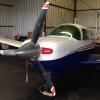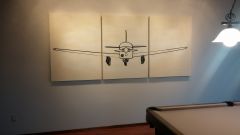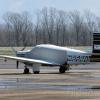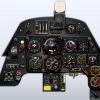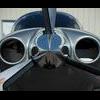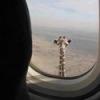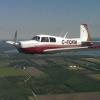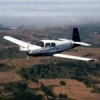Leaderboard
Popular Content
Showing content with the highest reputation on 07/24/2014 in all areas
-
5 points
-
I figure my C is a "low dollar traveling machine". If I wanted all the bells and whistles I'd go 201 or up. As a low dollar scheme, I don't want to go upside down on radios. I also looked at my flying profile. I've done all the 600 RVR Auto-lands I'll ever do. Done all the 200 & 1/2 in blowing snow I ever want to do. I don't have a need to PLAN a flight with a landing in those conditions anymore. I do want to be able to "occasionally" go cross-country (with high ceilings) direct, on top. I do want to be able to shoot non-precision GPS approaches "occasionally"! Where I live and fly, winter always means ice when IFR so, if I can't do it VFR I don't go. I do need to do an occasional ILS and marine layer climb out so IFR capability is needed. With all that in mind, I have a King 155 Nav-Com and a Garmin 155 TSO GPS with a Britain Accu-Trac auotopilot for straight and level flight. I use an iFly 700 on my control wheel to track the flight and approaches. I know if everything goes bad I can do an approach on just the iFly 700 if I absolutely had to in an emergency just like I used to practice CAT III 50 ft approaches (in good weather) by hand flying (CAT III for those not familiar is A/P Auto-land only). This fills my flying profile to a "T". I'd never get my money out of a C with top dollar radios. I'll never get top dollar for even a good C model (the market just isn't there). So, I fly cheap, I keep it in good shape and I enjoy relaxing and flying (sometimes without any radios on except the Xponder) for hours at a time. When it comes time to sell, it will sell for what it is worth and I'll have had 20 to 25 years of cheap flying.2 points
-
Was there another item on your bill, for the magneto fluid? Anyway, let us know what you find out.2 points
-
Left Saint Louis this morning heading for Oshkosh. Stopped in Rochelle, IL for fuel. They have a restaurant on the field open 11:00 am - 10:00 pm over the weekend. It is not just a burger joint. My wife had pan seared fish tacos and I had grilled chicken Caesar salad. Refueled and stuffed, only 120 more miles to go. We hIghly recommend this stop.1 point
-
Having bought and sold a couple of planes, I thought I would start a thread that might help first time airplane sellers. Tips for Prospective Sellers, presuming that you have an attractive airplane: 1. When composing an ad and when dealing with possible buyers, keep in mind that the name of the game is to provide enough comfort to the buyer that they will risk $500-$1,500 on a non-recoverable prebuy inspection of your airplane. 2. Especially in connection with pre-201 vintage airplanes, some of these aircraft have serious deficiencies due to damage, or incorrect or deferred maintenance. Since virtually every airplane ad starts out with the phrase "meticulously maintained" you have to say more than that to be convincing. 3. It is important to convince the prospective buyer that you are aware of the pertinent facts regarding your plane. Its shocking how many sellers I've spoken with who sincerely attest to no DH, when two minutes of Googling will uncover several accidents regarding their plane. In those instances, its not the DH that runs off the buyer, its the question of what else the seller doesn't know that is disconcerting. Making accurate statements regarding inop equipment too, telling somebody the plane is in perfect condition and then a three minute walkaround discloses broken equipment or big blue stains under the wings undermines buyer confidence in the seller. 4. Have a recent annual from a credible, well-known Mooney shop can be persuasive. The guy on the field who works on Skyhawks and does your annual for $500 a year doesn't carry too much weight with buyers - many of them are woefully unaware of the various Mooney Service Bulletins, etc. While the MSC or Mooney specialist may or may not do a better job than your local guy, their stamp of approval may get the buyer to pull the trigger on a prebuy. 5. Pricing is important to get people to call on the ad. When calculating your asking price, its OK to ask for a little more than you may be willing to accept, but be very careful about asking for a number that's wildly above the average on TAP for your model a/c. I see a lot of planes where the owner has taken the price he paid ten years ago, and then added in the cost of every tire and battery he's installed. You shouldn't expect to get added value from normal maintenance, only from bona fide upgrades, and even then you shouldn't expect to get a dollar for dollar increase in the planes value. If your asking price in the ad is much higher than the field, make sure the ad explains why by noting all of the new features. 6. Be friendly if contacted about your plane, respond promptly with pictures by email, don't mutter about tire kickers, etc. Also don't be shocked and dismayed if a long distance buyer asks for electronic copies of the logs. There are a lot of planes on the market and buyers are trying to determine which sellers are honest and reasonable people. Now that I have some experience I don't pursue relationships with crotchety sellers even if their planes are very attractive. 7. Importantly, keep the airplane flying regularly. Many if not most a/c for sale haven't flown much in the last two years. This interjects uncertainty as to the possibility of corrosion in the engine and the buyer will not offer top dollar. Not an appraiser, just wanted to share my perspective Tim1 point
-
He's doing well considering his age. A lot better than most would be. He didn't sign my test flight off but knew who did and he remembered the guy that signed off the AW in 64. Still lives in Kerrville and does receive guests who call ahead. I didn't stay too long as I didn't want to over stay my welcome or tire him out. He had a couple of good stories about the infamous flight with no bearings in the tail hinge and what his favorite early airframe was. Absolutely an A, Number One, person.1 point
-
1 point
-
If it could be sprayed directly onto a pair of offending pants... Hmmmmmmmmm, -a-1 point
-
Also, Seat Removal is a piece of cake. Pop out the cotter pins in the rear (or hitch pins if you had someone install the wrong equipment like I did initially) and slide the seat all the way back. When the back comes off the track, slide it all the way forward and lift the front. Place something protective and soft on your wing if you are taking it out by yourself, unless you can get it out, and get out of the cabin without sitting it down. (Very difficult task, but I may have tried it once successfully, and once without success).1 point
-
I have a '75C and you may want to also check with Mike Hudyma at SCS Interiors. (www.scs-interiors.com) They provided everything for me last year. My IA helped me to Apply Adhesive to the back of velcro and the back of the carpet for the mating velcro. Installed and it looks, feels, smells, and holds position great. They were very reasonable and were able to get me the lower kick panels, pilot and copilot carpet, rear bench carpet and baggage compartment carpet for a fraction of where I found it elsewhere.1 point
-
Not a big deal. There is likely a cotter pin at rear of tracks. Remove and push seat back off tracks and up/out. Carpet is commonly glued with an adhesive. Talking 30 minutes to do this...1 point
-
Wow. Holy cow .totally crazy...wonder why they want to kill GA. I had my trim servo in my J go about 10 yrs ago,thought a few hundy then was crazy...I hope you'll find a solution you can live with..this is just getting out of control wish u the best...1 point
-
1 point
-
Check all your screens in the system, too, to make sure they are clear. That includes the gascolator screen1 point
-
+1. I've been very lucky with my 4 (pre-owned) airplane purchases over the years and it's about 95% because I was dealing with great sellers. About two years ago I decided to add a Vans RV-8 to my hangar. Buying certificated aircraft is one thing, but buying homebuilts is a whole other animal. I'm not a builder or a gearhead, so I figured it would be smart to take my time and look at as many RV-8's as I could before I pulled the trigger (or not). I also thought it would be smart to buy from a builder if possible so I would get firsthand info about the plane and possibly technical support later on. It took a year before I found an aircraft and a builder/seller that I felt comfortable with. The builder shared my passion for bespoke machinery and built an RV-8 that the folks at the Mooney factory would have been proud of. He cut no corners, had flawless logs and documentation, and was very upfront about the plusses and minuses his aircraft. It also helped that I had met about 12-15 other builders along the way that put this guy and his airplane into perspective. I was a bit apprehensive about buying a homebuilt but I can say one year later that I have no regrets because I found a great seller who had a great aircraft.1 point
-
Exciting news! I received an email today from the Angel Flight Pilot Administrator. I'm officially an Angel Flight Pilot! After an orientation process, which we'll complete within the next couple of weeks, I'll be offering my flying services to patients and their familes! I'm really excited! It's a very rewarding feeling to be able to give back to some of our less fortunate fellow human beings around us who really need this specialized help in order to access medical care.1 point
-
For me the big plus would be getting the GDL-88 traffic and weather on my ipad in addition to the 650. For those with 430/530s, which don't have airway support, you could have to put in 15-20 waypts for a 1000nm trip, so for them it's also a plus.1 point
-
I have come to truly appreciate quality maintenance by people or companies with integrity. It is seldom the least expensive alternative, but quality rarely comes cheap. When you find that "golden" shop or mechanic, pay them what they ask for and do whatever else you have to do to keep them happy. It's that's important. I've got to question the guys who have been performing your maintenance and inspections - how do you miss a missing stud? On the other hand, there is the issue of "cheap" owners. Being frugal is one thing. But guys who intentionally cut corners? I've worked at a couple of places where they had rationalized skimping on proper and timely maintenance. I quit those jobs, it's just not worth it. People need to realize that skimping on or putting off maintenance ALWAYS ends up costing more in the long run. If you can't afford to properly maintain your airplane then you can't afford it. In my book, signing off and painting over a botched repair borders on criminal. You don't accidentally do crap like that, it was intentional. I would be pissed if I were you.1 point
-
Thanks for the reply Jose. This is the first time I'm hearing about the Flight Stream 210 system. I'm really surprised Garmin developed this product to be compatible with the GNS series as I thought they might choose to abandon the GNS units in favor of promoting the GTN series. Being able to connect wirelessly from your iPad to your onboard avionics is a real game changer in my opinion. I love the idea of transferring your flight plan without the need to twist endless knobs to enter a flight plan. Only downside is they will likely make it compatible only with Garmin Pilot and I'm a Wing X Pro guy. http://www.marketwatch.com/story/garmin-enhances-connext-with-wireless-cockpit-connectivity-to-mobile-devices-2014-07-221 point
-
My opinion is that some service providers think pilots are rich and have no budget limits which is not true. When you have $100 available, when you spent it all, there is no more. This means you have to make choices. By seeking lower rates for anything, you increase your options. Sometimes you can make savings without much effort... here is an example: Last year on our way to Oshkosh, we decided to stop in Sarnia Ontario for the night. As we arrive to a Motel at the counter the motel rep gave us the pricing for the night... I think it was $109 or so. I then ask, can I get a discount? He sais... are you CAA? I said no... but I said I am a pilot... he looked in his book and then said... would this been considered hospitality? I SAID YES Of course... this gave us a 20% discount on the room. If you just pay without asking questions, they have no incentive to lower the rates. My wife is all the opposite. She always pays without asking any questions. I kind of feel like I need to compensate for that behavior somehow so we get even... Yves1 point
-
I'm a frugal person by nature. Perhaps that was part of my attraction to Mooney? Besides, I'm a mechanical engineer, and the design and efficiency also appeal to me.1 point
-
1 point
-
1 point
-
fly it like you stole it. GPH is part of the equation. With the C you should be able to fly about 8-9GPH between 40 and 120 altitude and get pretty reasonable speeds and lay waste to someone flying a 172 burning 6 to 7 GPH1 point
-
Thanks for the inputs. It's done. It took 15 minutes to swap it. I don't plan to land at night a lot but now I feel a little more comfortable as my old one didn't work every time I did my preflight. Thanks.1 point
-
Based on my research and other topics I got Whelen PLED461L. My old one works only if I knock on the Plexiglas that I found difficult to do during the flight :-).1 point
-
My archive has a post I salted away from Rob Hoyle, who graciously provided the measurements and markings from the dipstick he (and the prior owner) calibrated for his 1964 C model, and which seems to be VERY well calibrated to my '66 E model. I stick the tanks before filling to see what I expect, and compare the result to my fuel totalizer and the numbers off the gas pump- the stick is usually right on the money. Get a wooden paint stir stick from Home Depot or similar, then mark it with a finepoint sharpie. The fuel soaks into the wood just enough to make it easy to see the level when you pull it out, but is dry enough to be easy to measure the next tank by the time you've walked over and pulled the cap. Inches Gallons 9 26 8 1/2 25 8 24 7 5/8 23 7 1/4 22 6 7/8 21 6 1/2 20 6 1/16 19 5 3/4 18 5 7/16 17 5 1/16 16 4 13/16 15 4 1/2 14 4 1/8 13 3 7/8 12 3 1/2 11 2 11/16 9 2 3/8 8 2 1/8 7 1 3/4 6 I can't remember the last time I procured ANYTHING for the airplane that was this cheap and useful. Regards, Knute '66 M20E - KSQL (San Carlos, CA)1 point




